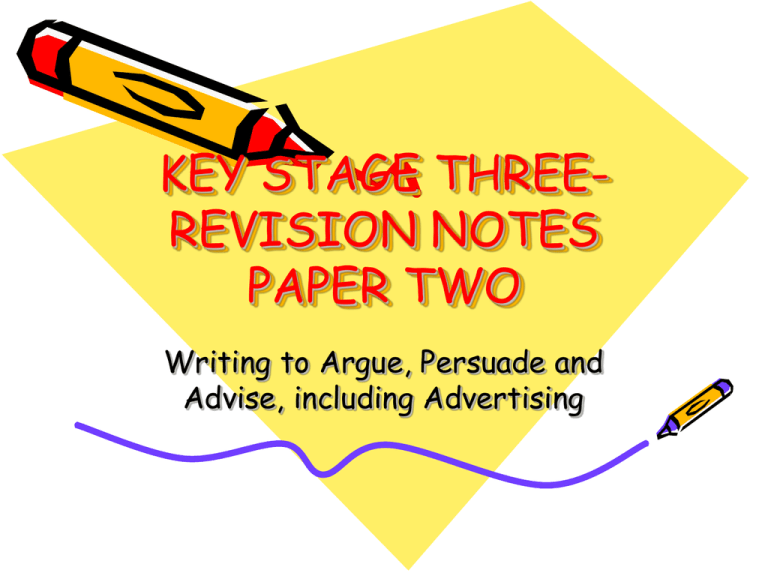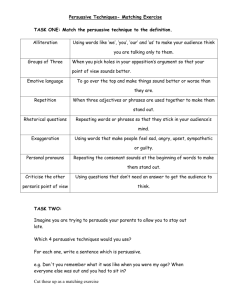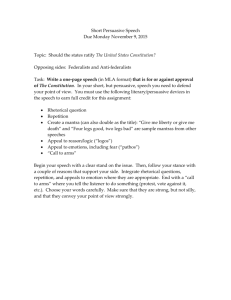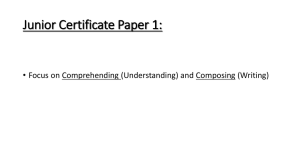KEY STAGE THREE-REVISION NOTES PAPER TWO
advertisement

KEY STAGE THREEREVISION NOTES PAPER TWO Writing to Argue, Persuade and Advise, including Advertising Have a WATCH and TIME yourself! • SECTION A Non Fiction Leaflet: 40 minutes • READING TIME: 10 Minutes • Section A, Question 1: 3-5 Minutes • Section A, Question 2: 5-7 Minutes • Section A, Question 3: 20 Minutes Have a WATCH and TIME yourself! • SECTION B Writing to Argue, Persuade and Advise: 35mins • BRAINSTORM your title, think of possibilities for your topic: 3 mins • PLAN your work-develop one point of argument per paragraph. 2mins • Use the rhetorical devices that are part of persuasive writing in your answer, e.g, rhetorical questions, repetition, exaggeration etc. Audience • AUDIENCE-the group of people that will read your piece of writing. • E.g., FHM-the audience would be males in their late teens to twenties. • E.g., The Rugrats Annual-the audience would be young children aged five to ten year olds. Audience Continued… • We know when a piece of writing is aimed at a young audience as the sentences will be short and simple with a limited vocabulary. • Teenagers are most difficult to write for as they need advice on certain things but do not want to be talked down to. Purpose • PURPOSE-the reason you are writing the article or piece of writing. • Reasons-to inform, entertain, explain, describe etc. • E.g., Sports Page-to inform readers about the latest sporting events. • E.g., Harry Potter Books- to entertain readers of all ages. • E.g., Recipe Instructions-to describe how to bake/cook something. Brochures • Brochures are booklets which provide us with information. • The language of a brochure is important as it needs to get the message across of what the brochure is about easily. • It is used to advertise new cars, supermarkets, charities and holidays. • Brochures are designed to inform and persuade. Leaflets • Leaflets are small sized texts (1-2 sides of A4) • The language is an important part of the text in order to allow the reader to know what it is about quickly. • Leaflets are aimed at a clear audience. • E.g., Risks to Health from Smoking-aimed at smokers. • E.g., MMR Vaccinations-Aimed at parents of young infants/toddlers. Writing to Persuade… • When writing to persuade you aim is to convince the reader about a certain topic or idea. • There are a number of techniques that we must recognise and must use in persuasive writing. • These techniques are known as RHETORICAL DEVICES and include; bias including (emotive language, selection, underplaying and exaggeration), repetition, short sentences, rhetorical questions and the use of ‘we’ or ‘you’ in the text itself. Bias in Persuasive Writing • When a referee ignores a foul by a team he/she likes, then he/she is described as biased. • The referee is judging unfairly because he/she likes one team more than another. • When news reporters allow their own views to affect the way they write about the news, this is also bias. Bias in Persuasive Writing • Bias does not mean lying about the facts-just presenting them in an unbalanced way. • There are three main types of bias: – Emotive Language – Selection (Leaving things out) – Exaggeration and Underplaying Persuasive Writing Continued… • Emotive Language creates an emotional reaction in the audience. • It gets the reader involved in the topic discussed. • Emotive words; anger, fury, shocking, kill, freedom, horrific, fabulous. • E.g., In Africa terrible poverty is depriving children of good health-they are dying and need help. Look at the following examples: • Read the following two slides. • Which slide grabs your attention and makes you feel threatened by the dangers of smoking? • Can you explain why one passage works better than the other? Example One-Smoking is not Good for you! • Smoking is not good for you. Cigarettes contain nicotine and this hurts your lungs very badly. The smoke is not good for you either. It can even dry up your skin so that when you are thirty you look much older. Smoking can lead to serious diseases. Example Two-Smoking is not Good for you! • People who are hooked on cigarettes forget some things. They forget the foul smell in their clothes, hair and teeth. They forget the way the smoke creeps silently into their skin, drying it from the inside. They forget the agony that disease will bring to them and their family. The Explanation… • The second slide grabs our attention for a number of reasons. • It uses emotive language to give the message more power, e.g., ‘…hooked…foul smells…smoke creeps silently…ignore…agony…’ • It uses repetition, e.g., ‘They forget…they forget…they forget… Selection in Persuasive Writing • Selection in persuasive writing means including some of the facts while leaving out others. • Look at the following example, what difference would it make if the words in bold were left out? Selection in Persuasive Writing… • The school has never had an exam failure because none of its pupils have ever taken an exam. It has a well equipped computing centre but no classrooms or teachers. • What kind of school is described above when we take away the bold writing? • This is known as selection. Exaggeration is best explained by an example… • The Liverpool striker found a gap the size of a battleship in Sheffield’s defence and torpedoed the ball into the net. The Sheffield goalie looked as if he was about to start blubbering like a two year old. • The reporter here has exaggerated (gone over the top) in relation to what happened at the football match. Underplaying is best explained by an example • The arrest of the Prime Minister’s son for trying to burn down Buckingham Palace has been a slight temporary setback for the government. A government spokesman blamed ‘youthful high spirits’ and added that ’This sort of thing happens all the time in politics.’ • Underplaying is the opposite of exaggeration. • It means making something smaller or less important than it really is. • E.g., The world ending tomorrow is seen a a slight setback for Prince Charles’ wedding. Repetition in Persuasive Writing • Repetition is the repeating of words and phrases in a text in order to emphasise a point. • Often patterns of three are used for effect in the text, e.g., They forget was used three times in the smoking example. • Martin Luther King’s famous ‘I have a Dream’ speech repeats ‘I have a dream..’ eight times in closely linked paragraphs. Short Sentences in Persuasive Writing • Short snappy sentences are often used in persuasive writing in order to have an impact with the audience or for emphasising a point. • E.g., Stop. Look. Listen. Live. These are the words of the recent advertising campaign for Road Safety persuading young people to be careful on the road. Rhetorical Questions in Persuasive Writing • Rhetorical Questions are questions used in a text where the writer does not expect to get an answer. • E.g., Where in the world would you expect to find a car as smooth as the new Toyota Avensis? • The question has been used as a means of drawing the reader in and the writer knows that nobody will answer the question. The use of ‘We’ and ‘You’ in Persuasive Writing • Writers often use ‘We’ to show that they have something in common with the reader/listener. • ‘E.g., ‘We help children suffering from all types of diseases.’ • Writers often use ‘You’ to address the reader directly in order to get their attention. • E.g., ‘Without your help these children do not have a chance of survival.’ Writing to Argue • When we write to argue we are writing in order to express a certain point of view. • Start off with a topic sentence that clearly shows what side of the debate you are on. • E.g., People who wear fur coats should be dragged out and shot for doing so. • The above topic sentence shocks the reader as well as showing what side of the debate the writer is on. Writing to Argue… • Argumentative writing is similar to persuasive writing in that is uses emotive language and rhetorical questions to help get the point across. • However argumentative writing should also include a mixture of facts and opinions to help with the argument. • E.g., I believe that anyone who wears fur is barbaric. (Opinion) • E.g., Almost 150foxes are slaughtered in order to create one fox coat. (Fact) Writing to Argue… • Argumentative writing also allows the writer to include some anecdotal evidence or personal stories to help support their point. • E.g., I saw how one animal was chained to a fence and starved to death in order that the fur would come off easily when it was time to make the coat. Writing to Advise • Writing to advise means telling the reader to carry out something for their own benefit or safety. • E.g., Stop Smoking, Change Your Eating Habits. • Writing to Advise is easy to recognise because of the following: Writing to Advise Key Points • Writing to advise includes the imperative verb, i.e., a verb giving an order. • E.g., Do…Stop…Give…Open…Turn • It also includes modal verbs, i.e., verbs that suggest something. • E.g., You May…Must…Should…Could… • The writer uses ‘I’ or ‘You’ as a means of speaking directly to the reader. Writing Letters • There are two types of letter you may be asked to write. • Formal Letter-a letter written when applying for a job or a place on a course or to express a point of view to a newspaper. • Informal Letter-a letter written to a friend or relative to stay in touch. Formal Letters • Formal letters have a fixed layout that you must follow to show that it is a formal letter. • If you know the person you are writing to, write Dear Mr.Sharvin and sign off with Yours sincerely. • If you do not know the person you are writing to, write Dear Sir/Madam and sign off with Yours faithfully. • Look carefully where the addresses and date is placed on the following letters. Formal Letter Layout-you know who you are writing to… De La Salle High Struell Road Downpatrick Co. Down 30/09/05 29 Struell Road Downpatrick Co. Down Dear Mr. and Mrs. McLoone, I am writing to let you know that your son has been expelled….(Detail of first paragraph) If you have any queries please do not hesitate to contact me…(Detail of second paragraph) Yours sincerely, Mr. Sharvin Formal Letter Layout-you do not know who you are writing to… De La Salle High Struell Road Downpatrick Co. Down 30/09/05 CGP Publications Main Street Downpatrick Co. Down Dear Sir/Madam, I am writing in relation to the books I ordered recently from your company…(Detail of first paragraph) Please let me know if you can solve this matter as it is urgent…(Detail of second paragraph) Yours faithfully, Mr. Sharvin Informal Letters • Informal letters are written to friends or relatives. • You need to include your address and the date. • You do not need to include the address of the person you are writing to. • Start with Dear John and finish with Best Wishes…Love from…Lots of Love… Informal Letter Layout 29 Struell Road Downpatrick Co. Down 30/09/05 Dear John, It’s Jim here. I hope you and your family are keeping well… (Detail of first paragraph) You’ll never guess what? I scored the winning goal…(Detail of second paragraph) I have to go now, I will call you soon. Don’t forget to write back! Best wishes, Jim Key Stage Three Letter Writing • Getting the correct letter layout is important however what you say is most important. • A good letter should be clear with a good structure, appropriate to audience and purpose. • In your exam you may be asked to write a formal letter to a magazine or newspaper explaining your point of view on something. Arguing in Letter Writing… • To argue convincingly you need to make a series of clear and logical points. • Use anecdotal evidence (personal stories), facts, opinions and examples to support your point. • You can give your argument more impact by using emotive language, rhetorical questions, repetition etc. Writing an Article… • You may be asked to write a newspaper or magazine article. • There are a number of steps you can take to prepare you for your article. • Look at the following and complete yourself in relation to the heading; There is not enough for teens to do in our area. Take the following steps in writing an article… • Brainstorm ideas on a page-What can teens do? Where do they go during the day? Where do they go at night? • Select five key points that you can develop into a paragraph. • Use examples, facts, opinions and anecdotal evidence to support your argument. • E.g., 200 teens between the age of 15 and 17 live on my estate and have nowhere to go to chill out. • (The above fact may not be true but show that you know to use facts etc in your argumentative writing). Writing an article continued… • Make sure you have a strong opening and ending to your article. • Use a rhetorical question, a quote from a song/poem or make a statement. • E.g., Children today need somewhere to hang out other than street corners! If you are writing a newspaper article… • Follow the same steps as shown before. • Make sure you have a catchy heading for your article. E.g., LEAVE THEM KIDS ALONE! • Use sub headings if you need to and make sure you use paragraphs. • Re-read your article to ensure it makes sense and to check for errors. Advertising • The aim of the language of advertising is to get a product or service noticed. • An advertisement wants to persuade us that his/her product is the best available so the language of advertising is quite often exaggerated. • E.g., Gilette the best a man can get! • E.g., Carlsberg, probably the best larger in the world! The Language of Advertising • Advertising often use clichés. Clichés are well known and often over used phrases. • E.g., Sun kissed beaches…Miles of golden sand…Sun, sea, sand and surf • Notice the four s’s in the last example. Having consonants that are the same beside each other is known as alliteration and used in writing for impact; to make it catchy. When looking at an advertisement consider the following: • What takes up the most space? Is there a reason for this? • Look at the colours. Do they suggest anything? Red-Danger…BlackSerious/Death…Green-Nature • What is in large print? • Is anything in bold or italics? When looking at an advertisement consider the following: • • • • Can you find a fact? Can you find an opinion? Can you find an example of exaggeration? Are there any pictures? If so, what is their purpose? • What is the purpose of headings, subheadings or bullet points if there are any included? Language we associate with Advertising: • WORDSNew…Free…Amazing…Miracle…Magic …Quick…Easy…Improved… • PHRASESNew Improved…Added Value …Country Fresh…Best Money Can Buy! Language we associate with Advertising: • COMPARATIVESFaster…Better…Happier…Brighter… • SUPERLATIVESFastest…Best…Happiest…Brightest… • COMPARATIVES– What’s so different about our music? – Why is everybody talking about Cool FM? Language we associate with Advertising: • IMPERATIVES– – – – – Try it today! Go on, Give it a go! Treat yourself Relax Sit back All of the above talk directly to the reader/audience Language we associate with Advertising: • SLOGANS-are catchy phrases that help us to remember a product or service. • Slogans often use rhyme, alliteration or puns. • E.g., You can do it when you B&Q it! (Rhyme) • E.g., Cool, crisp, clear Carlsberg (Alliteration) • E.g., Currys always cutting prices! (Pun) Language we associate with Advertising: • LOGOS-are often used in advertising by advertisers in order to help us remember the product/service. • They are most often symbols or emblems that represent the company or product. • E.g., The Coca Cola Ribbon • E.g., The Nike Swoosh Revision-Familiarise yourself with the following: • • • • Audience and Purpose Features of Leaflets and Brochures Rhetorical Devices & Biased Writing Features of Writing to Argue/Persuade/Advise • Letter Layout and Article Layout • Features of Advertising





